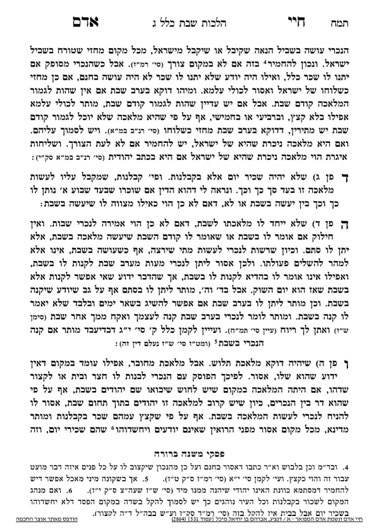We have finished siman 4, which discusses the criteria that the non-Jew be hired as a kablan. It is interesting that the Chayei Adam places this criterion as third, even though all of the other criteria revolve around this point. The heter for a non-Jew to work for a Jew on Shabbos begins from the fact that the non-Jew is working for himself, as we have discussed. The other points, that he must be paid, that the items are removed from the Jew’s premises before Shabbos, that it is not attached to the ground, that the Jew does not initiate the arrangement on Shabbos itself, and that it is not publicly known that the item belongs to the Jew, are all connected back to the point that he is a kablan (see more about the criteria in shiurim S0063-S0065).
Yesterday, we discussed one reason why the kablan is different from a sechir yom. There are some other reasons, which we will discuss today.
When a person is a shliach for another, the fact that they are paid does not detract from their status as a shliach. In fact, the Gemara says that being paid may strengthen the relationship between the employer and employee (yad poel k’yad baal habayis). For example, if one appoints a shliach to deliver a get, they are paid for the service and not by the hour. Nevertheless, they remain the shliach of the husband until they deliver the get. If so, we need to understand why the kablan arrangement is beneficial regarding amira l’akum.
The source of the concept of kablan is the Yerushalmi, quoted by Tosfos and others in the first perek of Shabbos. However, the Yerushalmi does not give a clear understanding as to the difference between a kablan and sechir yom.
Yesterday, we learned the explanation of the Shulchan Aruch Harav, who explained that the kablan’s primary responsibility is to finish the work. If so, in a certain sense, the work is separate from the connection to the Jewish employer. Even though the concept of shlichus applies to it, the separation was enough that Chazal did not impose the issur of amira l’akum. The thought process here is that if we can, in some way, sever the connection between the Jew and non-Jew in some way, Chazal did not impose their issur.
This difference is explained in three other ways throughout the rishonim. Some rishonim understand that a sechir yom is hired for that specific day, and cannot push off the work. A kablan is hired to complete a job, and can do the work when he chooses. If so, when he decides to perform the work, he is not doing it due to his connection to the Jew but due to his own decision. In this way, we have also severed the relationship between the non-Jew and the Jew, because the non-Jew gets to choose when he does the work.
A third way of understanding the difference is that a kablan gets paid per job, so the work is much more his work. The sechir yom gets paid per hour, so even if he is not working he is getting paid. This connects the sechir yom much more to the Jew.
A fourth way of understanding the difference is that a sechir yom is hired by the day, so the time element is the defining element. Even if the Jew does not explicitly state that the non-Jew should work on Shabbos, since the sechir yom is hired by the day, the fact the non-Jew is working on Shabbos (the time element) makes him connected to the Jew. The arrangement with the kablan has nothing to do with time, so even if the non-Jew performs the work on Shabbos there is no connection to the Jew. Add to this the fact that the non-Jew is working in order to get paid, and we consider him working for himself.
Summary
- If one instructs a non-Jew before Shabbos, there are times when it will be muttar, depending on eight conditions.
- The third condition is that the non-Jew be hired as a kablan. There are four ways to understand why he must be a kablan, all of which revolve around the point that the kablan works independently for himself while a sechir yom is more connected to his Jewish employer


